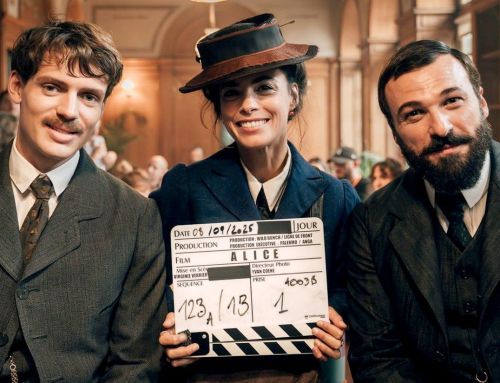INTERVIEW : Eddie Muller, Czar of Noir
These are tough times for movie lovers. Theaters across the country are closed, many libraries shuttered and people are staying home. However, there is still a way to enjoy watching films. In fact, it may give people a chance to see the more classic cinema that they’ve otherwise been ignoring. The Turner Classics Network (TCM) runs films 24/7 and perhaps the highlight of their line-up is the weekly segment “Noir Alley” hosted by noted film historian and “noirchaeloogist” Eddie Muller. I had the great pleasure of speaking with Muller, a conversation during which we naturally talked about what is probably the only area of motion pictures that never produced a bad movie: the wonderful world of film noir.
The cinematic French term refers to crime dramas made during Hollywood’s Golden Age. They were mostly black & white B-movies that attempted to display, through cigarette smoke and shadows, the darker side of American society. Their plots dealt with infidelity, blackmail and murder and the characters were private eyes, femme fatales and the proverbial cops and robbers, although, to say that these were movies about cops and robbers only, is a major understatement.
Watching film noirs is a matter of personal point of view. According to Muller (a.k.a. The Czar of Noir), “they’re perspective movies, which focus on the robbers instead of the cops.” What’s the difference? As I understood from Muller, a 1930s gangster film features an immoral Humphrey Bogart as a “criminal” whereas a film noir from the forties presents an immoral Bogart as anti-hero.” Obviously, the latter allows the viewer to sympathize with, admire, perhaps, the protagonist while the former tends to make the viewer root against him.
Another factor of the genre is style. The way a movie is shot is just as important as the way its story is told. This accounts for even a western or horror movie having elements of film noir. Of course, sometimes the style works in reverse as there are film noirs that have elements of science fiction or mystery.
Film noir supposedly started in the early forties. Many believe it was 1940’s “Stranger on the Third Floor” that ushered in the era. Although, Muller believes there were many films sprinkled around the pre-code period that could also be considered film noirs, including 1932’s “Afraid to Talk” and “Okay America.” Noir hit its heyday in the late forties and early fifties and lasted roughly until 1960. Memorable noirs include, 1941’s “I Wake up Screaming,” “Out of the Past” (1947) and Muller’s personal favorite, “In a Lonely Place,” which came out in 1950.
I asked Muller why he chose film noir as his area of expertise and he responded, “I didn’t pick it, it picked me” adding, “it just works with my wiring.” The San Francisco native further cited his love of Steve Ditko comic books and TV shows like, “The Fugitive” as early influences of noir themes. Muller, the son of a sports writer who covered boxing, no doubt also absorbed many of his father’s stories, which were soaked up in the same atmosphere as films like 1949’s “The Set-Up” and “The Harder They Fall,” 1956. It was 1949’s “Thieves Highway,” though, that first piqued Muller’s interest. “It showed me a San Francisco I didn’t recognize.”
Every major studio at the time produced film noirs, including Paramount, Warner Brothers and Universal. Muller, for his part, is emphatic when he asserts that, “RKO was the House of Noir.” The studio that Howard Hughes called home put out a record number of noirs including, “Born to Kill,” “They Live By Night” and “Angel Face” (all of which are currently available on DVD with audio commentaries by Muller).
Many a noir director has yelled “action!” to tough guys like, Richard Conte, Van Heflin, Robert Mitchum as well as bad girls like Jane Greer, Evelyn Keys and Gloria Graham. Those include Billy Wilder who directed “Double Indemnity,” Joseph Losey of “The Prowler” and Jacques Tourneur who directed what many believe is the quintessential film noir, 1947’s “Out of the Past.” However, Muller’s preferred auteur is Robert Siodmak who directed 1944’s “Phantom Lady,” 1946’s “The Killers” and 1949’s “Criss Cross.” “Siodmak, to me, had the most empathy with his doomed characters. He also maintained the best balance between all the filmic elements at his disposal. He was able to tell complicated narratives with ease and eloquence.”
Hosting TCM’s “Noir Alley” is just a small part of what Muller does for the art of film noir. In addition to the aforementioned DVD audio commentaries, he’s written several books, including “Dark City: The Lost World of Film Noir,” “The Art of Noir” and “Dark City Dames.” He also writes crime fiction novels including The Distance (Scribner) and Shadow Boxer (id.), among many others. He also organizes NOIR CITY, a premier traveling noir festival that was recently held in Hollywood. According to Muller, attendees are usually a 50/50 split of men and women with a wide range of ages, further cementing film noir’s universal appeal.
Of course, Muller’s greatest contribution to noir is his Film Noir Foundation, for which he sits as founder and president. FNF is a non-profit benefit corporation as a resource regarding the cultural, historical, and artistic significance of film noir as an original American cinematic movement. The foundation’s mission is to find and preserve films in danger of being lost or irreparably damaged, and to ensure that high-quality prints of these classic films remain in circulation for theatrical exhibition, Recent restorations include 1949’s “Too Late for Tears” and “The Man Who Cheated Himself” and “Woman on the Run,” both from 1950.
Keep up the good work, Eddie!
“Noir Alley” airs every Saturday at midnight on TCM.
For more information about Eddie Muller and his work with film noir, visit:
http://www.eddiemuller.com
http://www.noircity.com/foundation.html









